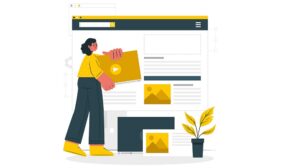WordPress Content Creation Training _ How do I create content in WordPress?
How do I create content in WordPress: Today’s websites serve as digital showcases for businesses and ideas. Whether you’re running an online store, a personal blog, a corporate website, or a news platform, every business needs a strong online presence. In the meantime, content management systems (CMS) allow users to easily create, edit, and manage their content without needing in-depth programming knowledge. WordPress has become one of the most popular options among these systems due to its user-friendliness and extensive capabilities.
WordPress Content Creation Training, including the use of Elementor, is an essential skill for web admins and content producers. Elementor is a popular page builder plugin for WordPress that allows you to create visually stunning and responsive designs without any coding knowledge. It’s a key tool for attracting and retaining user interest. New content is published online daily, and to compete in this space, content must be attractive, accurate, and optimized. For this reason, learning the proper steps for content creation can increase the quality of information, help improve your website’s SEO, and ultimately attract more visitors.
Here, we will examine the techniques, strategies, and best practices for content creation in WordPress. By providing practical solutions, you can create engaging and compelling content and turn your website into a trusted and popular resource in your field. Join us to discover the magic of content creation in WordPress and transform your online world.
Getting to know WordPress
WordPress is one of the world’s most popular and widely used content management systems (CMS), allowing users to create websites and blogs and launch online stores quickly. This platform was launched in 2003 and gradually became one of the leaders in this field. Here are some of the key features and benefits of WordPress:
Free and Open Source
WordPress is free and available to anyone. As an open-source platform, users can access its source code and modify it according to their needs, making WordPress more accessible.
User-Friendly
One reason for WordPress’ popularity is its simple and intuitive user interface. Even people who do not have much experience in web development can quickly familiarize themselves with it and design their websites.
Themes and Plugins
WordPress offers thousands of themes and plugins that allow users to customize the design and functionality of their website easily. This flexibility will enable you to create very diverse and unique websites. Some of the best WordPress themes are free, and you don’t have to pay anything to use them.

SEO-friendly
WordPress is SEO-friendly, which means it is designed in a way that makes it easier for search engines like Google to understand and rank your content. Plugins like Yoast SEO and All in One SEO Pack can help you optimize your content for search engines and, as a result, increase your website traffic.
Strong support and active community
WordPress boasts a large and active community of developers and users. This community provides easy access to guides, educational resources, and technical support, fostering a sense of belonging and shared learning.
Adapts to all types of websites
From simple blogs to complex e-commerce websites, WordPress can adapt to a wide range of needs, making it a highly flexible platform. Its suitability for digital marketing further enhances its appeal.
WordPress is a powerful tool for people who want to be visible in the digital world. This platform allows you to create engaging content that is easy to manage, helping you on your way to online success. WordPress is ideal if you are looking for an efficient and economical solution to creating your website.
Advantages and Disadvantages of WordPress
Here are the advantages and disadvantages of WordPress. Keep in mind that WordPress helps you build a site without writing a single line of code. Therefore, it makes sense to have a few disadvantages compared to programmed sites. However, there are many advantages to WordPress. Hiring a professional WordPress web designer can launch your site quickly and with high quality.
Advantages of using WordPress
Free and open source: WordPress is free and allows users to edit its code and change it to their liking.
Ease of use: Its simple and user-friendly interface allows users to manage their websites without special technical knowledge.
Plugin Support: Plugins allow you to add more functionality to your website. WordPress has over 55,000 free and paid plugins.
Variety of Themes: There are thousands of free and commercial themes that are easy to install and customize.
SEO Friendly: WordPress is great for search engine optimization (SEO), and many plugins are available to improve SEO. WordPress SEO is much faster than a coded site being SEO-friendly.
Large Community and Support: Many users and developers will answer your questions, and many learning resources are available.
Disadvantages of Using WordPress
Security: Due to the popularity of WordPress, its websites are often targeted by hackers. To do this, you must follow security tips and use plugins.
Loading Speed: Some plugins and themes can slow down the website. Optimal management and proper selection of themes and plugins help with this.
Maintenance Needs: WordPress requires regular updates to maintain performance and security, which can be time-consuming.
It may not be suitable for large projects: In some cases, more powerful and customized content management systems are needed for large and complex projects.
Providing Technical Support: Some users may require technical support to use plugins and themes, which may be costly.
Ultimately, choosing WordPress depends on your needs and goals. WordPress is a good option if you are looking for a simple and functional content management system.
WordPress Applications
In this section, we tried to name some of the most essential WordPress applications for you, my dears.
Blogging: WordPress was initially designed as a blogging platform and is still one of the best options for bloggers.
Corporate sites: Many companies use WordPress to create corporate websites and introduce services.
Online stores: WordPress can be a store platform using plugins like WooCommerce.
News and magazine sites: WordPress is suitable for managing a lot of content well.
Portfolios: Designers and artists can use WordPress to create their online portfolios.
Educational sites: Using plugins like LearnDash, you can offer online training courses with WordPress. You can easily design your educational site with the help of WordPress.
Forums: You can set up online forums using plugins like bbPress.
Membership Sites: WordPress has various features for creating membership sites and subscription courses.
Create Nonprofit Websites: Organizations can easily create websites with WordPress and share their news and events.
Do custom projects: You can easily do special projects with WordPress by programming and using custom plugins and themes.
WordPress is a popular choice for users with all levels of experience in web design due to its simplicity and breadth of features.

How do I create content in WordPress
What should WordPress content be like?
WordPress content is one of the key factors for optimizing a website and providing a better user experience. In white hat SEO, nothing is as effective as content creation and writing the right content. Below, we will review the essential tips and principles for creating an effective content structure in WordPress:
Using Categories and Tags
Categories: Divide your content into main categories. This helps users find content quickly and is also helpful for search engines.
Tags: Use tags to describe the details and characteristics of your content. This helps users discover related content quickly. This allows you to index your site and content quickly.
Use different content formats.
Use a combination of text, images, videos, and other media types to make the content more interesting and engaging for visitors.
Structure Headings and Subheadings
Main Title H1: Use a main title for the title of each page or post. This title should include keywords and clearly state the topic of the content.
SubheadingsH2, H3: Use subheadings to divide the content into different sections. This helps with readability and creates a proper structure for the content.
Writing valuable and practical content
Your content should meet users’ needs and answer their questions. Use comprehensive and reliable information and keep your content up-to-date and relevant. You should also have a content strategy to get better results from content placement in WordPress.
Internal and external linking
Internal linking: Point to other content on your website. This helps improve SEO and user experience.
External linking: Link to reliable and relevant sources. This increases the credibility of your content. These types of links are also called backlinks.
Using Images and Visual Media
Images, infographics, and videos can attract attention and increase comprehension. Images should also be optimized to reduce page load time.
Content Summary and Analysis
Provide a content summary at the end of each post or page. This will help users better understand the content provided and decide to read more.
Optimization for SEO
Content structure includes using appropriate keywords, meta tags, and descriptions to increase visibility in search engines. When posting content in WordPress, you must focus on on-page and off-page SEO.
Creating a regular and user-friendly content structure in WordPress improves user experience and increases Google’s input for the website. Following the above tips can provide attractive and valuable content to your audience.
How do I create content in WordPress
What are the steps to posting content in WordPress?
WordPress content creation is creating, editing, and publishing content on your website. Below are the steps and methods for WordPress content creation in detail:
Login to WordPress Dashboard
You can log in to your WordPress admin panel using your website’s admin login address (usually `yourdomain.com/wp-admin`).
Create a New Post
Go to the “Posts” or “Pages” in the sidebar.
To create a new post, click on “New Post” or “New Post”; to create a new page, select “New Page.”
Enter Title and Content
Title: Enter your post’s or page’s title at the top.
Text: Enter your content in the text editor (Editor). WordPress uses a block editor (Gutenberg) that allows you to add content as separate blocks.
Using Blocks
You can use a variety of blocks to insert titles, text, images, galleries, videos, etc. To add a new block, select the type of block you want. To learn how to remove and add white space between blocks in WordPress, visit our blog.
Images and Media
Use the “Image” or “Gallery” block to add images or other media files. You can also upload and manage files from the “Media” section in the sidebar. In the blog section, you can add images of your choice by clicking Add Multimedia File.
Layout and Design
You can customize the style and layout of your content using the blocks and sidebar settings.
You can apply custom settings such as colors, sizes, and fonts.
Optimize for SEO
SEO plugins like Yoast or All in One SEO Pack can help you optimize your content for search engines. These plugins will give you valuable tips on keywords, meta descriptions, and other SEO factors.
Choose Categories and Tags
In the right sidebar, you can choose categories and tags for your post. This will help you organize your content better.
Preview and Publish
Before publishing, you can preview your content by clicking “Preview.”
After final approval, click the “Publish” button to make your content available on the website.
Editing and Updating Content in WordPress
To edit previous content, go to the “Posts” or “Pages” section and select the desired post or page. After editing, you need to click on “Update” again.

How do I create content in WordPress
Best Practices and Tools for WordPress Content
For WordPress content writing, there are a variety of practices and tools that can help you produce high-quality and compelling content. Here are some of the best practices and tools:
Best Practices for WordPress Content
Content Planning: Plan and clearly define your topics before writing. A content calendar can help.
Keyword Research: Use keyword research tools to understand what terms users are searching for.
Proper Structure: Structure your articles and posts properly with H1, H2, and H3 headings so that they are easy to read.
Writing Valuable Content: Your content should be informative, engaging, and meet the needs of your readers.
SEO Optimization: Use SEO techniques to make your content more visible in search engines. Analyzing the site’s content when posting content in WordPress will be very helpful for SEO.
Using images and media: Images and videos can help make the content more attractive.
The best tools for posting content in WordPress
Yoast SEO: A plugin for optimizing content for SEO that gives you great tips.
Elementor: A page builder for designing attractive and personalized content.
Canva: You can easily use this tool to design images and social graphics.
Grammarly: This program is beneficial for checking grammar and writing. If your site is in English, be sure to use it.
Google Analytics: It helps analyze content performance and user behavior within the site. We also explained how to install Google Analytics on the site in a separate blog.
Ahrefs or SEMrush: Powerful tools for analyzing competitors and finding the right keywords.
CoSchedule Headline Analyzer: This is used to optimize titles and headlines.
You can gain experience writing content in WordPress using these methods and tools.
How do I create content in WordPress
What is SEO, and how does it help with content creation in WordPress?
SEO, which stands for “Search Engine Optimization,” refers to a set of techniques and practices that aim to improve the ranking of websites in search results. This increases organic (unpaid) traffic to the website. Below, I will explain in more depth what SEO is and how it is done:
Types of SEO
On-page SEO: It is related to optimizing the content of website pages, including titles, meta tags, URLs, and written content.
Off-page SEO: This includes activities that take place outside of your website, such as link building and social media engagement.
Technical SEO improves your website’s technical aspects, such as loading speed, mobile compatibility, and site structure.
12 Steps to Implementing SEO
Keyword Research: Identifying keywords related to your site’s topic and their search volume can help determine its content. Tools like Google Keyword Planner and Ahrefs are helpful.
On-page SEO Optimization: Page Title and Meta Description: Each page should have a unique title and meta description with keywords.
Use Headings: Headings can help organize your content and improve readability. The SEO checklist can help you remember these steps.
Quality Content: Your content should be valuable, relevant, and optimized.
Image Optimization: Use alt text for images and optimize image size.
Off-page SEO Optimization: Link Building: Try to attract links from reputable websites or blogs. Getting quality backlinks helps your site’s credibility.
Social Media Activity: Share your content on social media to attract more traffic.
Technical SEO Optimization: Page Loading Speed: Pages should load quickly. Use tools like Google PageSpeed Insights to assess and improve speed.
Mobile Compatibility: Make sure your website is optimized for mobile devices.
Use Sitemaps: A sitemap can help search engines have a map of your website.
Analytics and Monitoring: Use tools like Google Analytics and Google Search Console to monitor website performance and identify strengths and weaknesses.
Constant Update: SEO is a continuous process. Update your content and adjust your strategies based on changes in search engine algorithms and user behavior. These tips and practices can improve your website’s SEO and make it more visible in search results.

How do I create content in WordPress
Conclusion
In the end, learning to post content on WordPress is a valuable skill and an art that allows you to tell your story uniquely. Using this powerful platform, you can create remarkable content that attracts your audience and provides them with an unforgettable experience.
Remember that high-quality content is the cornerstone of any successful website. By combining attractive texts and pleasing images and choosing the right color combination and font, you can turn your website into a destination and a source of inspiration. Beyond that, by using SEO and optimization techniques, you can reach more visitors and multiply the impact of your content.
Paying attention to the needs of your audience and regularly updating your site’s content is the key to success in the digital world. With persistence, creativity, and passion for creating content, you can embark on an exciting journey and become a professional writer and content creator. Finally, know that every post and article you publish is an opportunity to connect and impact the lives of others. So, continue this journey confidently and fill the digital world with your voice.